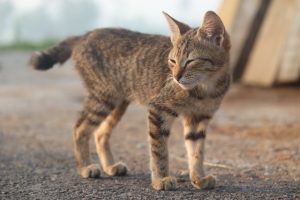James Gorman reports How the Cat Gets Its Stripes:
A team of geneticists reported Tuesday in the journal Nature Communications that it had identified a gene in domestic cats that plays a key role in creating the traditional tabby stripe pattern, and that the pattern is evident in embryonic tissue even before hair follicles start to grow.
The inheritance of cat coats — how to breed for this or that pattern — is well known. But how patterns emerge in a growing embryo “really has been an unsolved mystery,” said Dr. Gregory S. Barsh, an author of the new report.
….
From more than 200 prenatal litters, Dr. [Kelly] McGowan looked for patterns in the tissue at the different stages of growth in the embryos. She found a pattern of what she described as thick and thin areas of tissue in the top layer of the embryonic skin, never before reported. The regions, she said, “mimic what’s going on in the adult cat pigmentation patterns.” The same patterns that will appear in an adult cat’s coat as stripes or blotches appear first in the embryo before there is any hair or even hair follicles.
The team then looked for genes that might be active at that period in early embryonic growth.
When Dr. Kaelin looked at the tissue that showed the thick and thin tissue pattern that was the precursor of stripes, he said, “the one molecule that stood out from the rest was this Dkk4.” The full name of the protein and the gene is Dickkopf 4: The name is German for “thick head,” a characteristic the gene produced in frogs.

